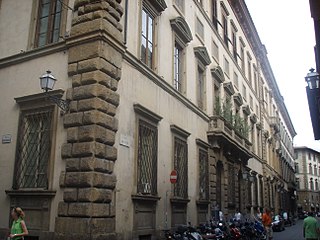Related Research Articles

Palazzo Mozzi or Palazzo de' Mozzi is an early Renaissance palace, located at the end of the Piazza de' Mozzi that emerges from Ponte alle Grazie and leads straight to the palace where via San Niccolò becomes via de' Bardi in the Quartiere of Santo Spirito in the Oltrarno section of Florence, region of Tuscany, Italy. The 13th-century palace housed the gallery of the highly successful antiquarian Stefano Bardini, of which the remnants were left to the commune, where they assembled the Museo Bardini or Mozzi Bardini, displaying Florentine art and artifacts up to the early Renaissance. The gardens elaborated against the hillside behind the palace were added mainly by Bardini.

The Florence Courthouse is a large 21st-century complex on the Viale Guidoni in the Novoli quarter of Florence, Tuscany, Italy.

Palazzo Gondi is a palace in Florence, Italy, located a block from Piazza della Signoria. It was built in 1490 under design by Giuliano da Sangallo, who was inspired by other major works of stately buildings in the city, such as Palazzo Medici and Palazzo Strozzi. Among the elements borrowed from these earlier works are the cube-shape set around a central courtyard, the ashlar sloping on each of three floors, and the arched windows.

Luigi Bellincioni was an Italian architect and engineer.

The Casino Mediceo di San Marco is a late-Renaissance or Mannerist style palace located on Via Cavour number 57 and via San Gallo in Florence, region of Tuscany, Italy.

The Palazzo di Bianca Cappello, originally belonging to Corbinelli family is a Renaissance-style palace located on Via Maggio #26 of the quarter of Oltrarno in Florence, region of Tuscany, Italy. It is notable for its facade decoration, and once housing Bianca Cappello, the mistress, then wife of the Grand-Duke Francesco I de' Medici

The Palazzo Nonfinito is a Mannerist-style palace located on Via del Proconsolo #12, in central Florence, region of Tuscany, Italy. Begun in 1593 using designs by the architect Bernardo Buontalenti, only the ground floor was completed, and additional construction was added later by different architects. The palace houses the Anthropology and Ethnology section of the Museum of Natural History of Florence.

The Palazzo Pazzi, also known as the Palazzo della Congiura or Palazzo Pazzi-Quaratesi is a Renaissance-style palace. It is located on Via del Proconsolo 10 at the corner with Borgo Albizzi in Florence, region of Tuscany, Italy. The palace is between the Palazzo Nonfinito and the Palazzo Pazzi-Ammannati to the north.

The Palazzo Orlandini del Beccuto, also known as Palazzo Gondi di Francia is a palace located with entrance on Via de' Pecori #6-8 in central Florence, region of Tuscany Italy.

The Palazzo Ramirez de Montalvo, also known as Palazzo Matteucci is a palace located on Borgo degli Albizi #26 in central Florence, region of Tuscany Italy.

The Palazzo Mondragone, also known as Palazzo Mandragone, Ambron(n), Ricasoli di Meleto, or Peyron, is a palace located on Via del Giglio #4r-8r in central Florence, region of Tuscany Italy.

The Palazzo Rinuccini is a palace located on Via Santo Spirito #39 in central Florence, region of Tuscany Italy.

The Palazzo Pucci is a palace located at Via dei Pucci 4 in central Florence in the region of Tuscany, Italy. The façade of the palace spans from Via dei Servi to Via Ricasoli.

A ferro or ferro da facciata is an item of functional wrought-iron work on the façade of an Italian building. Ferri are a common feature of Medieval and Renaissance architecture in Lazio, Tuscany and Umbria. They are of three main types: ferri da cavallo have a ring for tethering horses, and are set at about 1.5 metres from the ground; holders for standards and torches are placed higher on the façade and on the corners of the building; arpioni have a cup-shaped hook or hooks to support cloth for shade or to be dried, and are set near balconies.
The Palazzo Viviani della Robbia is a Baroque-style palace located on Via de Tornabuoni #15, corner with Via della Spada, in the quartieri of Santa Maria Novella, city of Florence, region of Tuscany, Italy.

The Palazzo or Casa Martelli was a residential palace, and since 2009, a civic museum displaying in situ the remains of the original family's valuable art collection, as well as its frescoed rooms. The palace is located on Via Ferdinando Zannetti 8 near the corner with Via Cerretani in central Florence, region of Tuscany, Italy.

Luigi Catani is an Italian painter of frescoes during the neoclassical period, active in Tuscany.

The Palazzo Canacci, also known as Palazzo Canacci-Giandonati is a Gothic-style palace located in Piazza di Parte Guelfa 3 in central Florence, region of Tuscany, Italy. It stand across the piazza from the former church of San Biagio, and separated by an alley from the Palazzo di Parte Guelfa.

The Palazzo Naldini, or Naldini Del Riccio', or also Niccolini al Duomo, is a Florence palace located on the corner of Piazza del Duomo 28 rosso and Via dei Servi 2–4.
References
- ↑ Palazzo Spinelli, Repertorio delle Architetture Civile di Firenze, entry on palace, entry by Claudio Paolini.
- ↑ Notizie e guida di Firenze e de' suoi contorni, Presso Guglielmo Piatti, Florence (1841), page 371.